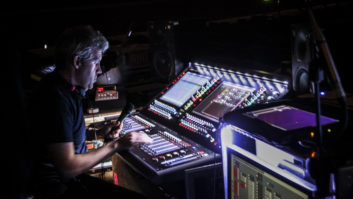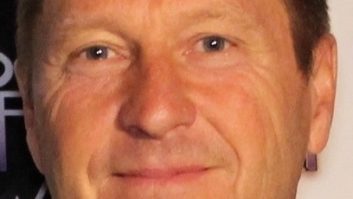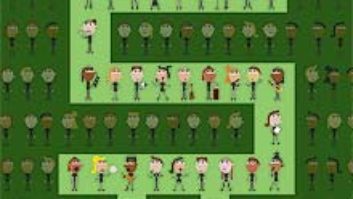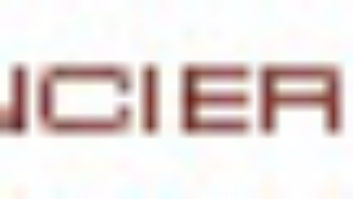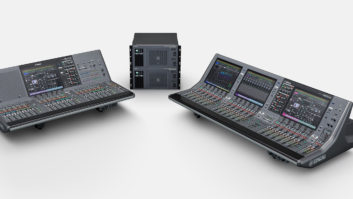NEW YORK, NY—The floor of Madison Square Garden hadn’t seen something like this in a long time. In one night, an in-the-round stage presented both New Orleans-based Preservation Hall Jazz Band and hip-hop pioneer Grandmaster Flash, but they were merely leading up to one of the biggest indie rock bands of all-time.
With the crowd sufficiently worked up, Arcade Fire entered the arena like championship athletes as ropes rose up from the sides of the stage, turning it into a boxing ring where the band ripped into the title track off its latest album, Everything Now, all the while flanked by two large disco balls refracting laser lights. The disco vibe couldn’t have been a coincidence, as the album is the group’s most danceable to date. It may have been a long way from the vibe of its 2010 album, The Suburbs, but the crowd didn’t seem to mind.
While most tours are booked so that a production has time to find its groove before playing a high-profile New York gig, Arcade Fire’s Infinite Content tour hit Madison Square Garden only four shows into its North American run. Nonetheless, the shakedown period had gone well—a crucial fact, given that the band is carrying with it reportedly the largest AVB-based touring system yet assembled, fielded by audio provider Solotech (Montreal/Las Vegas).
The in-the-round PA sports two sets of main left-right hangs, with each hang comprised of a dozen L-Acoustics K1 line array boxes atop four K2s. The two sets of side hangs each have left-right arrays of 16 K2s. Supplementing all of that are four independent hangs, each with eight KS28 subs, flown in cardioid configurations. Powering the entire system are no less than 92 LA12x amplifiers, 80 of which are hung above the stage in four custom amp rack cages. There’s so much equipment flown directly above the stage, it almost looks like a cave of sound built for the band.
All of it is held together using the AVB digital audio protocol. While this is the largest touring AVB rig to date, Solotech systems engineer Marc-Oliver “Marco” Germain, who also toured with the band behind its 2013 Reflektor album, had no qualms about that arrangement. “As soon as I knew this [AVB-based system] was available, I said ‘I want to try that,’” he said. “From my computer, I can do the patch for the whole system, changing it on the fly; I did that this morning, re-patching 92 amps in five minutes.”
Calling it a “viable standard,” Germain built the system using only AVNU Alliance-certified products to ensure compatibility—primarily two Meyer Sound Galileo Galaxy units, 11 Extreme Networks Switches and 92 L-Acoustics LA12x amplified controllers. Germain handles main distribution from a Meyer Sound Galileo Galaxy at FOH, which generates two AVB streams of eight channels that are sent over fiber optic cable to switches that use spanning-tree protocol to ensure redundancy. Each rack of 20 LA12x amplifiers above the stage is connected via two switches, so that if a switch fails, the system can fall over to the other one by swapping a fiber; each rack additionally has 12-pair analog cabling as backup, just in case. From each rack’s switches, Cat 5 cabling connects to the individual amplifiers, with the longest run a mere 48 feet. The result is clear, reliable sound, said Germain. That and “Sometimes I feel more like an IT guy than a sound guy.”
Mixing the sound that threads through that AVB system is FOH engineer Jim Warren. For this tour, Warren is happily relying on his trusty Avid Venue S6L console, finding it’s been particularly helpful with the new danceable elements of the latest album. “It’s got a massive channel count—lots of ins, lots of outs—so things I used to run out of on [my old] Venue system, I don’t run out of now,” he said. “Also, it sounds absolutely amazing. I was never really worried about the sound of the Venue—and then once I started using the S6L, I was very surprised how much difference there was.”
A veteran FOH engineer for Radiohead, Warren aims to overcome challenges inherent to an in-the-round set-up. For example, singer Regine Chassagne is featured more prominently on the new album, often with heavily effected vocals, particularly in the breezy “Electric Blue.” Warren noted, “It’s been a challenge between getting those big, fat vocal sounds and not putting those effects on for the entire band, who are standing all around her.”
The key to getting those vocals is in the way he approaches building the mix. “Trust your ears, and when you do your sound-check, do your vocal first,” he advised. “It’s the most important thing—see how loud you can get your vocals, how clear you can get them, and then work everything else in around it. Nobody goes home whistling the kick drum.”
While Warren has his work cut out for him nightly, he appears to barely break a sweat behind the S6L. Germain has been working with Warren for years, and their familiarity is a plus, too: “I’ve been dealing with Jim for a few years now, I know what he’s expecting and so I just carry on doing the same contour or EQ curve on the general system, and then he deals with where he wants to boost things. The system itself can handle pretty much anything. We’ve got songs with really heavy bass pads, like ‘Here Comes the Night Time,’ and the new one, ‘Electric Blue,’ has a nice, heavy low end. But it’s always under control, even on a song like ‘No Cars Go,’ where the low end is punchy. It all comes down to what comes out of Jim’s desk. It’s supposed to be showing up everywhere in the arena, and that’s happened so far.”
While the sound was strong, showmanship was on the agenda as well. Arcade Fire is known for having a plethora of performers onstage at once, and during “Haiti,” it even brought out a Haitian dancer who negotiated the space around her surprisingly well. Elsewhere, midway through its set, the band displayed a phone on the video screens, instructing the audience to turn on its smartphone lights. The rest of the lights slowly dimmed (save for the red exit signs) and Madison Square Garden was illuminated by its vast audience as the band played “Neon Bible.” It wasn’t quite the ‘switch-to-12-pair-cabling’ analog emergency that Solotech prepared for, but it was a beautiful sight to behold.
Solotech
Solotech.com
L-Acoustics
l-acoustics.com
Avid
Avid.com
